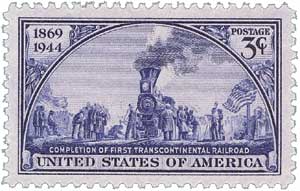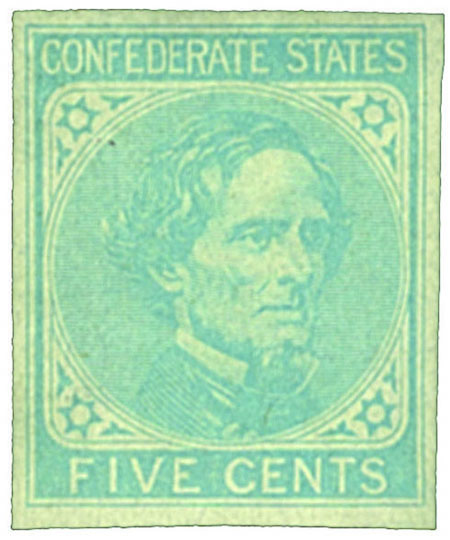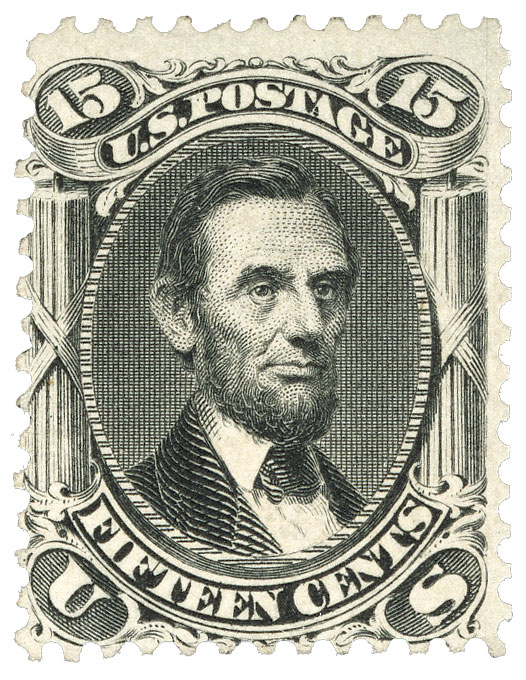
# 922 - 1944 3c Completion of First Transcontinental Railroad
3¢ First Transcontinental Railroad
City: Omaha, NE; Ogden, UT; San Francisco, CA
Quantity: 61,303,000
Printed by: Bureau of Engraving and Printing
Printing Method: Rotary Press
Perforations: 11 x 10.5
Color: Violet
Transcontinental Railroad Completed

On May 10, 1869, the Transcontinental Railroad was completed with the driving of the golden spike at Promontory Summit, Utah.
Talks about a railroad spanning America began as early as 1832, when Dr. Hartwell Carver suggested one from Lake Michigan to Oregon. Congress began to seriously consider the idea in the late 1840s, following the discovery of gold in California.
| Did you know each of these stamps is “clickable?” You can click on each one to learn more about it and buy it for your collection! |

In the early 1850s, Secretary of War Jefferson Davis directed a series of Pacific Railroad Surveys to explore possible routes. Their extensive research produced 12 volumes on the nature and native people of the west. This research also led to the Gadsden Purchase, which acquired land in the future states of Arizona and New Mexico along the proposed route.
By 1856 the House of Representatives had formed a Select Committee on the Pacific Railroad and Telegraph. They declared that, “The necessity that now exists for constructing lines of railroad and telegraphic communication between the Atlantic and Pacific coasts of this continent is no longer a question for argument; it is conceded by every one. In order to maintain our present position on the Pacific, we must have some more speedy and direct means of intercourse than is at present afforded by the route through the possessions of a foreign power.”

By the early 1860s, it was agreed that the railroad was necessary, but as the nation was embroiled in the slavery debate that would soon send them into Civil War, no one could agree if the eastern terminus should be in a Northern or Southern city. Talks stalled when the war began. But then in 1862, President Lincoln signed the Pacific Railroad Act. This act gave the Union Pacific and Central Pacific railroad companies the responsibility of creating a transcontinental railroad route, roughly following the 42nd parallel from Omaha, Nebraska, to Sacramento, California. Railroad lines in Chicago were to be extended to meet the new railroad in Omaha.
The Union Pacific Railroad Company began heading west from Council Bluffs, Iowa, while the Central Pacific built eastward from Sacramento, California. For their efforts, Congress granted these railroad companies large tracts of land and millions of dollars in loans. The Central Pacific began work on their end of the railroad on January 8, 1863. Located thousands of miles from the eastern manufacturing centers, they had a long wait for their supplies, which were transported by ship around South America’s Cape Horn or through the Isthmus of Panama. Construction on the Union Pacific Railroad didn’t begin until after the end of the war, in July 1865.
When the war ended, many Army veterans worked for the Union Pacific along with Irish immigrants. Labor was hard to find in the West, but Chinese immigrants diligently pushed the railroad over the Sierra Nevada mountains.
This historic achievement marked the first time a railroad had spanned an entire continent. The transcontinental railroad did a great deal to speed the settlement and industrial growth of the U.S. By the end of the 1800s, the U.S. had five transcontinental rail lines. The “Pacific Railroad,” as it was first called, opened the west to trade, travel, and settlement. It marked the end of dangerous stagecoach and wagon journeys. Towns seemed to appear overnight along the route.
Click here to view photos from joining ceremony and more.
3¢ First Transcontinental Railroad
City: Omaha, NE; Ogden, UT; San Francisco, CA
Quantity: 61,303,000
Printed by: Bureau of Engraving and Printing
Printing Method: Rotary Press
Perforations: 11 x 10.5
Color: Violet
Transcontinental Railroad Completed

On May 10, 1869, the Transcontinental Railroad was completed with the driving of the golden spike at Promontory Summit, Utah.
Talks about a railroad spanning America began as early as 1832, when Dr. Hartwell Carver suggested one from Lake Michigan to Oregon. Congress began to seriously consider the idea in the late 1840s, following the discovery of gold in California.
| Did you know each of these stamps is “clickable?” You can click on each one to learn more about it and buy it for your collection! |

In the early 1850s, Secretary of War Jefferson Davis directed a series of Pacific Railroad Surveys to explore possible routes. Their extensive research produced 12 volumes on the nature and native people of the west. This research also led to the Gadsden Purchase, which acquired land in the future states of Arizona and New Mexico along the proposed route.
By 1856 the House of Representatives had formed a Select Committee on the Pacific Railroad and Telegraph. They declared that, “The necessity that now exists for constructing lines of railroad and telegraphic communication between the Atlantic and Pacific coasts of this continent is no longer a question for argument; it is conceded by every one. In order to maintain our present position on the Pacific, we must have some more speedy and direct means of intercourse than is at present afforded by the route through the possessions of a foreign power.”

By the early 1860s, it was agreed that the railroad was necessary, but as the nation was embroiled in the slavery debate that would soon send them into Civil War, no one could agree if the eastern terminus should be in a Northern or Southern city. Talks stalled when the war began. But then in 1862, President Lincoln signed the Pacific Railroad Act. This act gave the Union Pacific and Central Pacific railroad companies the responsibility of creating a transcontinental railroad route, roughly following the 42nd parallel from Omaha, Nebraska, to Sacramento, California. Railroad lines in Chicago were to be extended to meet the new railroad in Omaha.
The Union Pacific Railroad Company began heading west from Council Bluffs, Iowa, while the Central Pacific built eastward from Sacramento, California. For their efforts, Congress granted these railroad companies large tracts of land and millions of dollars in loans. The Central Pacific began work on their end of the railroad on January 8, 1863. Located thousands of miles from the eastern manufacturing centers, they had a long wait for their supplies, which were transported by ship around South America’s Cape Horn or through the Isthmus of Panama. Construction on the Union Pacific Railroad didn’t begin until after the end of the war, in July 1865.
When the war ended, many Army veterans worked for the Union Pacific along with Irish immigrants. Labor was hard to find in the West, but Chinese immigrants diligently pushed the railroad over the Sierra Nevada mountains.
This historic achievement marked the first time a railroad had spanned an entire continent. The transcontinental railroad did a great deal to speed the settlement and industrial growth of the U.S. By the end of the 1800s, the U.S. had five transcontinental rail lines. The “Pacific Railroad,” as it was first called, opened the west to trade, travel, and settlement. It marked the end of dangerous stagecoach and wagon journeys. Towns seemed to appear overnight along the route.
Click here to view photos from joining ceremony and more.







